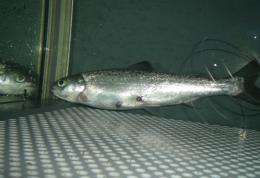Toxins produced by algae lead to deviant behavior and changes in brain activity in salmon

Salmon exposed to algal-produced neurotoxins show changes in both their brain activity and general behavior.
It has also been found that very small doses of these toxins can have an affect on how salmon relate to other fish. These toxins are some of those that can cause food poisoning in people who eat contaminated mussels.
Marit Bakke has studied three different neurotoxins: saxitoxin, brevetoxin and domoic acid and the effects that relatively low doses of these contaminants have on salmon. She has described some characteristic features of salmon’s general behaviour and how it changes under the influence of these toxins, such as loss of balance and equilibrium and swimming aimlessly. In addition, she examined the glucose metabolism in the brain by means of radioactively treated glucose as a marker. The degree of marker accumulation corresponded to the neuroactivity in the areas of the brain being studied, and in this way, Bakke demonstrated that different parts of the brain undergo changes when influenced by these toxins.
Saxitoxin and domoic acid were administered in such low doses that it was not possible to detect changes in swimming patterns. Nevertheless, Bakke was able to prove that the toxins had an effect on how the fish related to new fish that were released into the aquarium. This would indicate that fish exposed to even small concentrations of algal toxins may therefore tackle new situations in a different way to fish which have never been exposed to such toxins.

Marine algal toxins are often the cause of food poisoning in humans who have eaten shellfish. But such toxins also affect animals living in the sea, either via direct absorption from the water or because the food they eat is contaminated. In the case of farmed fish, the consequences can be serious because they cannot escape from areas contaminated with algae and algal toxins. It is often difficult to detect cases where fish are exposed to very low doses of algal toxins or their potential consequences. Bakke’s doctoral research demonstrates several possible ways of detecting algal toxins, even in low concentrations.
Bakke carried out her doctoral project at the Norwegian School of Veterinary Science and at the Norwegian Institute for Water Research’s research station by the Oslo Fjord at Solbergstrand near Drøbak.
More information: Cand.scient. Marit Jørgensen Bakke defended her doctorate at the Norwegian School of Veterinary Science on 7th June 2012 with a thesis entitled “Effects of algal-produced neurotoxins on fish.”
Provided by Norwegian School of Veterinary Science

















